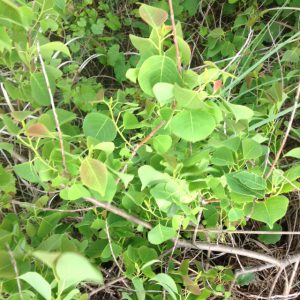For lesson 3 we are going to look at an invasive plant. I could be wrong, but I am guessing you either have one of these in your yard, or very nearby. This would be the Chinese Tallow – also called the “popcorn tree”.

Rick O’Connor
It is called the “popcorn tree” because the fruits develop a white waxy tallow covering that make them appear to be popcorn. These usually appear between August and November. As the name implies, it is a tree and one of the few in northwest Florida where the leaves change color in the fall. This is one reason many people enjoy having the plant in their yard.
However, it is invasive.
1) It is from China – non-native
2) It was brought here by humans. In this case intentionally. It was originally brought as an ornamental landscaping plant, but it was discovered that the seed oil had other uses, such as making soap.
3) It causes an environmental and, in some cases, an economic problem.
The environmental problem is primarily the overcrowding/out competing of native plants. A tall tree, 40-50 ft. tall, can produce over 100,000 seeds which are dispersed by birds and spread the invasion. They will grow in full sun and in shade areas but tend to invade disturbed areas. They are most commonly found along the sides of roads, lots that have been cleared for development or farming, along fence rows, or in parks. Where they grow, they can be numerous and spread throughout the area. I have seen one group take over the bottom of a retention pond. They appear to be salt tolerant as well – I have seen them growing on Pensacola Beach.

Choctawhatchee Basin Alliance.
On the economic side, they are toxic to cattle – and can be to humans as well. The economics here would be the farmers cost in removing and “battling” the plants spread across the pasture.
ACTIVITY
So how many in your yard?
How many on your block? Or, if you do not live on a city block – how many on your road?
Do you notice where they are growing? Is it in one section of a yard? Along only one section of our road?
Th chance of rain in Pensacola is very low today (Apr 6,2020) and it is a good one to get out and look for these trees.
You may ask afterwards… “what can we do about this plant?”
Well again, some people like it for its color, and want to keep it in their yard.
If it is on public property, you can report on EDDMapS – https://www.eddmaps.org/. This will let local managers know it is there. If you have it in your yard and want to remove it there are few things you can do.
1) Look for seedlings and remove. Once you know what they look like, you will begin to notice them everywhere. As mentioned, seed dispersal by birds is a common and so even if you do not have one in your yard, you may have the seedlings.
2) If you have trees, you are going to have to use an herbicide to do this. If interested in how that is down – email me and let me know.
WELL, IT IS TIME TO GO OUTSIDE AND SEE IF THIS PLANT IN THE NEIGHBORHOOD!
Have fun and stay safe.
 0
0
